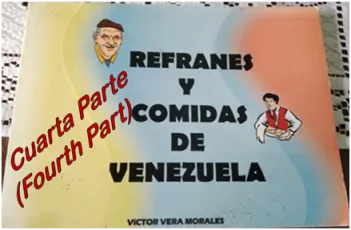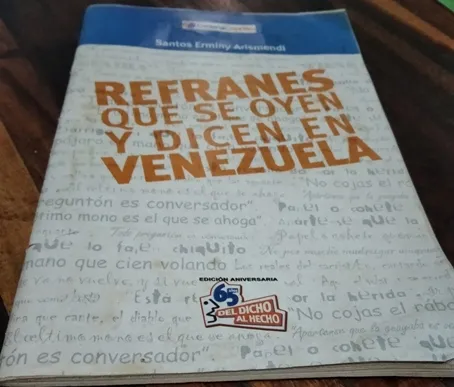En esta publicación les ofrezco otra parte de “Cinco sabios refranes venezolanos”. Siendo la cuarta entrega, coloco al final de este post los links correspondientes a las tres primeras, (por si quieren leerlos). En esta oportunidad también me apoyo en el libro escrito por mi abuelo, Víctor Vera Morales “El Poeta” y, como siempre, las interpretaciones son de mi autoría. Próximamente estaré empleando otro libro, (que es muy bueno si de refranes se trata), cuyo autor es Santos Erminy Arismendi: “Refranes que se oyen y dicen en Venezuela”, publicado por la Cadena Capriles en Agosto del año 2006, ejemplar que venía encartado de forma gratuita en el periódico “Últimas Noticias” de aquel entonces.
In this publication I offer you another part of "Five wise Venezuelan sayings." Being the fourth installment, I place at the end of this post the links corresponding to the first three, (in case you want to read them). This time I also rely on the book written by my grandfather, Víctor Vera Morales "El Poeta" and, as always, the interpretations are my own. Soon I will be using another book, (which is very good if it is about sayings), whose author is Santos Erminy Arismendi: "Sayings that are heard and said in Venezuela", published by Cadena Capriles in August 2006, copy that came inserted for free in the newspaper "Últimas Noticias" at that time.


1) “Más peligroso que mono con hojilla.” Este refrán nos lleva a imaginarnos cuán peligroso puede resultar un primate al cual se le entrega una hojilla. Se aplica a aquellos individuos que tienen algún poder (hojilla), y careciendo del conocimiento y capacidades, en vez de hacer buen uso del mismo, lo que ocasionan es daño, peligro, desastres.
“More dangerous than monkey with razor.” This saying leads us to imagine how dangerous a primate who is handed a blade can be. It applies to those individuals who have some power (blade), and lacking knowledge and capabilities, instead of making good use of it, what they cause is damage, danger, disaster.
 2) “Esa es una pelea de burro contra tigre.” Dicho aplicable cuando en una confrontación existe un claro desequilibrio, es decir uno de los contendientes es más hábil, más ágil, más fuerte, con más experiencia o más poderoso que su contrario, por lo que se trata de una pelea desigual en donde el más débil lleva todas las de perder.
2) “Esa es una pelea de burro contra tigre.” Dicho aplicable cuando en una confrontación existe un claro desequilibrio, es decir uno de los contendientes es más hábil, más ágil, más fuerte, con más experiencia o más poderoso que su contrario, por lo que se trata de una pelea desigual en donde el más débil lleva todas las de perder.
"That is a donkey versus tiger fight." Said applicable when in a confrontation there is a clear imbalance, that is, one of the contestants is more skillful, more agile, stronger, with more experience or more powerful than his opposite, so it is an unequal fight where the weaker takes all to lose.
 3) “A Dios rogando, y con el mazo dando.” Según la conseja popular, este refrán se originó cuando un carretero que se había accidentado, se encontró con San Bernardo quien aún en vida fue canonizado y era famoso por hacer milagros; así que aprovechó y le pidió que rogase a Dios por la reparación de la carreta, a lo el santo le respondió: “Sí, hijo mío, yo rogaré a Dios, pero mientras tú debes seguir dándole con el mazo.” Por tanto, este dicho expresa que si bien la fe y confianza en Dios es vital, el trabajo y esfuerzo humano aporta la otra mitad necesaria para tener éxito.
3) “A Dios rogando, y con el mazo dando.” Según la conseja popular, este refrán se originó cuando un carretero que se había accidentado, se encontró con San Bernardo quien aún en vida fue canonizado y era famoso por hacer milagros; así que aprovechó y le pidió que rogase a Dios por la reparación de la carreta, a lo el santo le respondió: “Sí, hijo mío, yo rogaré a Dios, pero mientras tú debes seguir dándole con el mazo.” Por tanto, este dicho expresa que si bien la fe y confianza en Dios es vital, el trabajo y esfuerzo humano aporta la otra mitad necesaria para tener éxito.
"A god praying and with the hammer giving." According to the popular knowledge, this saying originated when a carter who had been injured met Saint Bernard, who was canonized while still alive and was famous for performing miracles, so he took advantage of it and asked him to pray to God for the repair of the cart, to which the saint replied: "Yes, my son, I will pray to God, but while you must continue giving him with the mallet." Therefore, this saying expresses that although faith and trust in God is vital, human work and effort contributes the other half necessary to be successful
 4) “Esas son lágrimas de cocodrilo.” Refrán que se utiliza para decir que una persona está expresando un dolor que no siente, un dolor fingido e hipócrita a través de lágrimas falsas; y esto se debe a que existe la infundada creencia de que los cocodrilos lloran después de comerse a sus presas.
4) “Esas son lágrimas de cocodrilo.” Refrán que se utiliza para decir que una persona está expresando un dolor que no siente, un dolor fingido e hipócrita a través de lágrimas falsas; y esto se debe a que existe la infundada creencia de que los cocodrilos lloran después de comerse a sus presas.
"Those are crocodile tears." A saying that is used to say that a person is expressing a pain they do not feel, a feigned and hypocritical pain through false tears, and this is because there is an unfounded belief that crocodiles cry after eating their prey.
 5) “¿Quién te ha dado velas en este entierro?” En décadas anteriores era una práctica común que en los entierros, a los familiares del difunto se les hiciera entrega de velas; así que cuando una persona que no era allegada y recibía un candil, se consideraban entrometido. De esta forma, el refrán se aplica a aquellas personas curiosas e imprudentes, que se meten en asuntos que no les conciernen.
5) “¿Quién te ha dado velas en este entierro?” En décadas anteriores era una práctica común que en los entierros, a los familiares del difunto se les hiciera entrega de velas; así que cuando una persona que no era allegada y recibía un candil, se consideraban entrometido. De esta forma, el refrán se aplica a aquellas personas curiosas e imprudentes, que se meten en asuntos que no les conciernen.
"Who gave you candles at this funeral?" In previous decades, it was a common practice that at funerals, the relatives of the deceased were given candles; so when a person who was not close received a lamp, they considered themselves nosy. In this way, the saying applies to those curious and reckless people, who get into matters that do not concern them.
 Queridos lectores, seguidamente coloco los links de las tres primeras entregas, por si las quieren leer: / Dear readers, below I place the links of the first three installments, in case you want to read them:
Queridos lectores, seguidamente coloco los links de las tres primeras entregas, por si las quieren leer: / Dear readers, below I place the links of the first three installments, in case you want to read them:
Fuentes Bibliográficas / Bibliographical sources:
Víctor Vera Morales. (Agosto 2004). Refranes y Comidas de Venezuela. Editado por el Instituto Municipal de Publicaciones de la Alcaldía de Caracas.
Fuentes de las imágenes / Image sources:
- Fotos de mi autoría, tomada con un teléfono REDMI 8A, intervenida con WordArt / Photos of my authorship, taken with a REDMI 8A telephone, intervened with WordArt.
- Los diseños incluidos en esta publicación, han sido elaborados por mi persona con la aplicación CANVA / The designs included in this publication has been made by me with the CANVA application.
En caso de que se requiera emplear el contenido o imágenes de este post y de mis otras publicaciones, agradecería se hiciera referencia a mi autoría (Fabiola Martínez Morales) y se citara el link correspondiente. Gracias.
In the event that it is required to use the content or images of this post and my other publications, I would be grateful if my authorship (Fabiola Martínez Morales) was made and the corresponding link was cited. Thank you.











